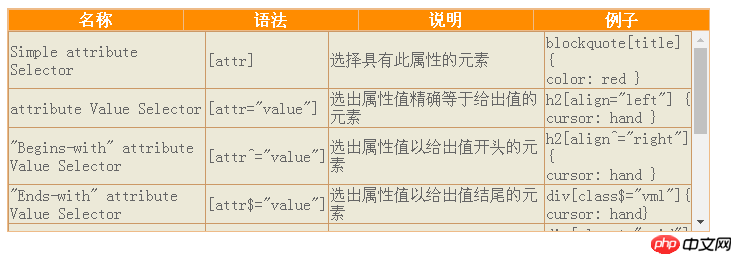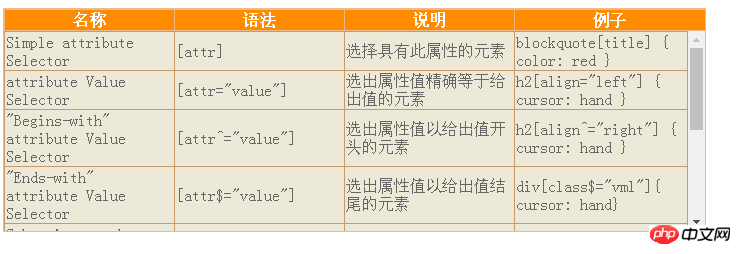Code example for fixing table header using pure CSS
The content of this article is about the code example for realizing table header fixation in pure CSS. It has certain reference value. Friends in need can refer to it. I hope it will be helpful to you.
The reason why it is difficult to fix the table header with pure CSS is mainly due to two points. First, IE6, which has the largest market share, does not support position:fixed. Another thing is that people want to achieve this effect in a table.
We know that CSS is responsible for performance, and HTML is responsible for structure. The same structure, but changing the style, will give people a completely different feeling. This also shows that human eyes are easily deceived. Therefore, in the days when p CSS was enthusiastically advocated, people always wanted to remove tables from the page and used p span to create "tables" one by one. Although this kind of thing is not advisable, it also tells us that what table can do, we can also do it through some combinations. To put it another way, since one table cannot be done, just two. The upper table simulates the header, and the lower table simulates the part with scroll bars. Before we go any further, let's clarify our needs first, without being too abstract. First, the table is 4*9, each column is 170px wide, and the total is 680px. The scroll bar defaults to 16px in each browser. Don’t forget, the width does not include the border. There are 5 vertical borders in four columns. The width Total length is 701px.
Then we divide this table into two. The first table is the header, and the second table should have a scroll bar, which means that the overflow style should be applied to its parent element, so it needs to be coated with a p. This p and the first table should be of equal length. But don’t bother, we just put a p outside them, set their width to 701px, and then set the width of these two sub-elements to 100%. Note that we explicitly add tbody to the table to improve the rendering efficiency of the table.
<p> </p>
| 名称 | 语法 | 说明 | 例子 |
|---|
| Simple attribute Selector | [attr] | 选择具有此属性的元素 | blockquote[title] { color: red } |
| attribute Value Selector | [attr="value"] | 选出属性值精确等于给出值的元素 | h2[align="left"] { cursor: hand } |
| "Begins-with" attribute Value Selector | [attr^="value"] | 选出属性值以给出值开头的元素 | h2[align^="right"] { cursor: hand } |
| "Ends-with" attribute Value Selector | [attr$="value"] | 选出属性值以给出值结尾的元素 | p[class$="vml"]{ cursor: hand} |
| Substring-match attribute Value Selector | [attr*="value"] | 选出属性值包含给出值的元素 | p[class*="grid"]{ float:left} |
| One-Of-Many Attribute Value Selector | [attr~="value"] | 原元素的属性值为多个单词,给出值为其中一个。 | li[class~="last"]{ padding-left:2em} |
| Hyphen Attribute Value Selector | [attr|="value"] | 原元素的属性值等于给出值,或者以给出值加“-”开头 | span[lang|="en"]{ color:green} |
| 反选属性值选择器 | [attr!="value"] | 非标准,jQuery中出现的 | span[class!="red"]{ color:green} |
Presentation layer part:
#scrollTable {
width:701px;
border: 1px solid #EB8;/*table没有外围的border,只有内部的td或th有border*/
background: #FF8C00;
}
#scrollTable table {
border-collapse:collapse; /*统一设置两个table为细线表格*/
}
#scrollTable table.thead{ /*表头*/
/*p的第一个子元素*/
width:100%;
}
#scrollTable table.thead th{/*表头*/
border: 1px solid #EB8;
border-right:#C96;
color:#fff;
background: #FF8C00;/*亮桔黄色*/
}
#scrollTable p{/*能带滚动条的表身*/
/*p的第二个子元素*/
width:100%;
height:200px;
overflow:auto;/*必需*/
}
#scrollTable table.tbody{/*能带滚动条的表身的正体*/
width:100%;
border: 1px solid #C96;
border-right:#B74;
color:#666666;
background: #ECE9D8;
}
#scrollTable table.tbody td{/*能带滚动条的表身的格子*/
border:1px solid #C96;
}Running code:
nbsp;html>
<meta>
<title>纯CSS实现表头固定</title>
<style>
#scrollTable {
width:701px;
border: 1px solid #EB8;/*table没有外围的border,只有内部的td或th有border*/
background: #FF8C00;
}
#scrollTable table {
border-collapse:collapse; /*统一设置两个table为细线表格*/
}
#scrollTable table.thead{ /*表头*/
/*p的第一个子元素*/
width:100%;
}
#scrollTable table.thead th{/*表头*/
border: 1px solid #EB8;
border-right:#C96;
color:#fff;
background: #FF8C00;/*亮桔黄色*/
}
#scrollTable p{/*能带滚动条的表身*/
/*p的第二个子元素*/
width:100%;
height:200px;
overflow:auto;/*必需*/
}
#scrollTable table.tbody{/*能带滚动条的表身的正体*/
width:100%;
border: 1px solid #C96;
border-right:#B74;
color:#666666;
background: #ECE9D8;
}
#scrollTable table.tbody td{/*能带滚动条的表身的格子*/
border:1px solid #C96;
}
</style>
<p>
</p>| 名称 | 语法 | 说明 | 例子 |
|---|
| Simple attribute Selector | [attr] | 选择具有此属性的元素 | blockquote[title] { color: red } |
| attribute Value Selector | [attr="value"] | 选出属性值精确等于给出值的元素 | h2[align="left"] { cursor: hand } |
| "Begins-with" attribute Value Selector | [attr^="value"] | 选出属性值以给出值开头的元素 | h2[align^="right"] { cursor: hand } |
| "Ends-with" attribute Value Selector | [attr$="value"] | 选出属性值以给出值结尾的元素 | p[class$="vml"]{ cursor: hand} |
| Substring-match attribute Value Selector | [attr*="value"] | 选出属性值包含给出值的元素 | p[class*="grid"]{ float:left} |
| One-Of-Many Attribute Value Selector | [attr~="value"] | 原元素的属性值为多个单词,给出值为其中一个。 | li[class~="last"]{ padding-left:2em} |
| Hyphen Attribute Value Selector | [attr|="value"] | 原元素的属性值等于给出值,或者以给出值加“-”开头 | span[lang|="en"]{ color:green} |
| 反选属性值选择器 | [attr!="value"] | 非标准,jQuery中出现的 | span[class!="red"]{ color:green} |

It is found that the grid of the table header is not aligned with the grid of the table body. At this time we need to use the col tag. col allows us to uniformly set the background color, text alignment and width of td or th with the same index value in tbody. Although the adjacent selector of CSS2.1 and the sub-element filtering pseudo-class of CSS3 allow us to set them in a more streamlined way, and the style and structure are separated, it is a pity that the IE family always lags behind. Let's take a look at their lengths again. Since the last table may be squeezed by the scroll bar and shortened in length, we just need to ensure that the lengths of the first three columns are equal, and the rest are allocated to the last one. In other words, the last one does not need to be set. In addition, you can set the style of the scroll bar in IE, let's play around with it.
Presentation layer part:
#scrollTable {
width:701px;
border: 1px solid #EB8;/*table没有外围的border,只有内部的td或th有border*/
background: #FF8C00;
}
#scrollTable table {
border-collapse:collapse; /*统一设置两个table为细线表格*/
}
/*表头 p的第一个子元素**/
#scrollTable table.thead{
width:100%;
}
/*表头*/
#scrollTable table.thead th{
border: 1px solid #EB8;
border-right:#C96;
color:#fff;
background: #FF8C00;/*亮桔黄色*/
}
/*能带滚动条的表身*/
/*p的第二个子元素*/
#scrollTable p{
width:100%;
height:200px;
overflow:auto;/*必需*/
scrollbar-face-color:#EB8;/*那三个小矩形的背景色*/
scrollbar-base-color:#ece9d8;/*那三个小矩形的前景色*/
scrollbar-arrow-color:#FF8C00;/*上下按钮里三角箭头的颜色*/
scrollbar-track-color:#ece9d8;/*滚动条的那个活动块所在的矩形的背景色*/
scrollbar-highlight-color:#800040;/*那三个小矩形左上padding的颜色*/
scrollbar-shadow-color:#800040;/*那三个小矩形右下padding的颜色*/
scrollbar-3dlight-color: #EB8;/*那三个小矩形左上border的颜色*/
scrollbar-darkshadow-Color:#EB8;/*那三个小矩形右下border的颜色*/
}
/*能带滚动条的表身的正体*/
#scrollTable table.tbody{
width:100%;
border: 1px solid #C96;
border-right:#B74;
color:#666666;
background: #ECE9D8;
}
/*能带滚动条的表身的格子*/
#scrollTable table.tbody td{
border:1px solid #C96;
}Running code:
nbsp;html>
<meta>
<title>纯CSS实现表头固定 </title>
<style>
#scrollTable {
width:701px;
border: 1px solid #EB8;/*table没有外围的border,只有内部的td或th有border*/
background: #FF8C00;
}
#scrollTable table {
border-collapse:collapse; /*统一设置两个table为细线表格*/
}
/*表头 p的第一个子元素**/
#scrollTable table.thead{
width:100%;
}
/*表头*/
#scrollTable table.thead th{
border: 1px solid #EB8;
border-right:#C96;
color:#fff;
background: #FF8C00;/*亮桔黄色*/
}
/*能带滚动条的表身*/
/*p的第二个子元素*/
#scrollTable p{
width:100%;
height:200px;
overflow:auto;/*必需*/
scrollbar-face-color:#EB8;/*那三个小矩形的背景色*/
scrollbar-base-color:#ece9d8;/*那三个小矩形的前景色*/
scrollbar-arrow-color:#FF8C00;/*上下按钮里三角箭头的颜色*/
scrollbar-track-color:#ece9d8;/*滚动条的那个活动块所在的矩形的背景色*/
scrollbar-highlight-color:#800040;/*那三个小矩形左上padding的颜色*/
scrollbar-shadow-color:#800040;/*那三个小矩形右下padding的颜色*/
scrollbar-3dlight-color: #EB8;/*那三个小矩形左上border的颜色*/
scrollbar-darkshadow-Color:#EB8;/*那三个小矩形右下border的颜色*/
}
/*能带滚动条的表身的正体*/
#scrollTable table.tbody{
width:100%;
border: 1px solid #C96;
border-right:#B74;
color:#666666;
background: #ECE9D8;
}
/*能带滚动条的表身的格子*/
#scrollTable table.tbody td{
border:1px solid #C96;
}
</style>
<p>
</p>| 名称 | 语法 | 说明 | 例子 |
|---|
| Simple attribute Selector | [attr] | 选择具有此属性的元素 | blockquote[title] { color: red } |
| attribute Value Selector | [attr="value"] | 选出属性值精确等于给出值的元素 | h2[align="left"] { cursor: hand } |
| "Begins-with" attribute Value Selector | [attr^="value"] | 选出属性值以给出值开头的元素 | h2[align^="right"] { cursor: hand } |
| "Ends-with" attribute Value Selector | [attr$="value"] | 选出属性值以给出值结尾的元素 | p[class$="vml"]{ cursor: hand} |
| Substring-match attribute Value Selector | [attr*="value"] | 选出属性值包含给出值的元素 | p[class*="grid"]{ float:left} |
| One-Of-Many Attribute Value Selector | [attr~="value"] | 原元素的属性值为多个单词,给出值为其中一个。 | li[class~="last"]{ padding-left:2em} |
| Hyphen Attribute Value Selector | [attr|="value"] | 原元素的属性值等于给出值,或者以给出值加“-”开头 | span[lang|="en"]{ color:green} |
| 反选属性值选择器 | [attr!="value"] | 非标准,jQuery中出现的 | span[class!="red"]{ color:green} |

The above is the detailed content of Code example for fixing table header using pure CSS. For more information, please follow other related articles on the PHP Chinese website!

Hot AI Tools

Undresser.AI Undress
AI-powered app for creating realistic nude photos

AI Clothes Remover
Online AI tool for removing clothes from photos.

Undress AI Tool
Undress images for free

Clothoff.io
AI clothes remover

Video Face Swap
Swap faces in any video effortlessly with our completely free AI face swap tool!

Hot Article

Hot Tools

Notepad++7.3.1
Easy-to-use and free code editor

SublimeText3 Chinese version
Chinese version, very easy to use

Zend Studio 13.0.1
Powerful PHP integrated development environment

Dreamweaver CS6
Visual web development tools

SublimeText3 Mac version
God-level code editing software (SublimeText3)

Hot Topics
 How to use bootstrap in vue
Apr 07, 2025 pm 11:33 PM
How to use bootstrap in vue
Apr 07, 2025 pm 11:33 PM
Using Bootstrap in Vue.js is divided into five steps: Install Bootstrap. Import Bootstrap in main.js. Use the Bootstrap component directly in the template. Optional: Custom style. Optional: Use plug-ins.
 The Roles of HTML, CSS, and JavaScript: Core Responsibilities
Apr 08, 2025 pm 07:05 PM
The Roles of HTML, CSS, and JavaScript: Core Responsibilities
Apr 08, 2025 pm 07:05 PM
HTML defines the web structure, CSS is responsible for style and layout, and JavaScript gives dynamic interaction. The three perform their duties in web development and jointly build a colorful website.
 Understanding HTML, CSS, and JavaScript: A Beginner's Guide
Apr 12, 2025 am 12:02 AM
Understanding HTML, CSS, and JavaScript: A Beginner's Guide
Apr 12, 2025 am 12:02 AM
WebdevelopmentreliesonHTML,CSS,andJavaScript:1)HTMLstructurescontent,2)CSSstylesit,and3)JavaScriptaddsinteractivity,formingthebasisofmodernwebexperiences.
 How to set up the framework for bootstrap
Apr 07, 2025 pm 03:27 PM
How to set up the framework for bootstrap
Apr 07, 2025 pm 03:27 PM
To set up the Bootstrap framework, you need to follow these steps: 1. Reference the Bootstrap file via CDN; 2. Download and host the file on your own server; 3. Include the Bootstrap file in HTML; 4. Compile Sass/Less as needed; 5. Import a custom file (optional). Once setup is complete, you can use Bootstrap's grid systems, components, and styles to create responsive websites and applications.
 How to write split lines on bootstrap
Apr 07, 2025 pm 03:12 PM
How to write split lines on bootstrap
Apr 07, 2025 pm 03:12 PM
There are two ways to create a Bootstrap split line: using the tag, which creates a horizontal split line. Use the CSS border property to create custom style split lines.
 How to insert pictures on bootstrap
Apr 07, 2025 pm 03:30 PM
How to insert pictures on bootstrap
Apr 07, 2025 pm 03:30 PM
There are several ways to insert images in Bootstrap: insert images directly, using the HTML img tag. With the Bootstrap image component, you can provide responsive images and more styles. Set the image size, use the img-fluid class to make the image adaptable. Set the border, using the img-bordered class. Set the rounded corners and use the img-rounded class. Set the shadow, use the shadow class. Resize and position the image, using CSS style. Using the background image, use the background-image CSS property.
 How to use bootstrap button
Apr 07, 2025 pm 03:09 PM
How to use bootstrap button
Apr 07, 2025 pm 03:09 PM
How to use the Bootstrap button? Introduce Bootstrap CSS to create button elements and add Bootstrap button class to add button text
 How to resize bootstrap
Apr 07, 2025 pm 03:18 PM
How to resize bootstrap
Apr 07, 2025 pm 03:18 PM
To adjust the size of elements in Bootstrap, you can use the dimension class, which includes: adjusting width: .col-, .w-, .mw-adjust height: .h-, .min-h-, .max-h-






